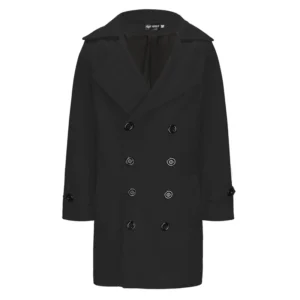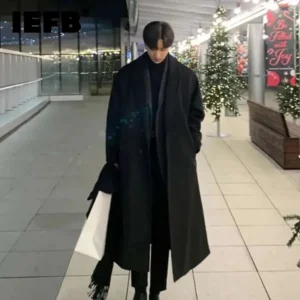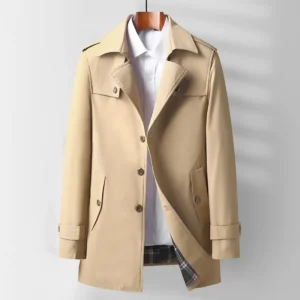The Versatility of Lightweight Topcoats
A lightweight topcoat represents one of the most adaptable pieces in a man’s wardrobe. Unlike their heavier winter counterparts, these refined garments typically weigh under 3 pounds (1.4 kg) and feature thinner construction that allows for comfortable movement and easy layering. What sets lightweight topcoats apart is their ability to provide just enough warmth without the bulk that characterizes winter outerwear.
The practical benefits of these garments cannot be overstated. A well-chosen lightweight topcoat transitions effortlessly between seasons, offering protection from spring breezes and fall chills while remaining comfortable for indoor wear. Their streamlined silhouette allows them to complement both casual weekend ensembles and sharp business attire without overwhelming either look.
While heavier overcoats prioritize insulation and weather protection, lightweight topcoats emphasize versatility and style. Materials like cotton blends provide breathability, tropical wool offers temperature regulation, and lightweight twill delivers durability with minimal weight—each serving specific functional purposes beyond mere aesthetics.
At their core, lightweight topcoats bridge the gap between casual and formal settings, functioning as sophisticated wardrobe investments rather than seasonal afterthoughts. Understanding the proper choosing right coat length significantly impacts how versatile your topcoat can be. Throughout this guide, we’ll explore fabric selection, fit considerations, and styling approaches that will help you maximize your topcoat’s potential across various settings.
For those ready to expand their wardrobe, exploring quality men’s topcoats provides excellent starting options for building a versatile collection.
Understanding Lightweight Topcoat Fabrics
The fabric of your lightweight topcoat fundamentally influences its drape, weight, and styling versatility. Different materials create distinct impressions and suit specific situations, making fabric selection a crucial consideration for any topcoat purchase.
Common lightweight topcoat fabrics include:
Cotton and Cotton Blends: Offering exceptional breathability and casual versatility, cotton topcoats typically weigh between 12-16 ounces (340-450g) per yard. These fabrics excel in mild weather and casual settings, providing a relaxed structure that pairs well with everyday attire.
Lightweight Wool: Perhaps the most versatile option, lightweight wool (under 10.5oz/300g per yard) delivers impressive temperature regulation with a refined appearance. The natural drape creates a flattering silhouette while remaining comfortable across seasons.
Technical Fabrics: Modern technical materials provide superior weather resistance while maintaining a contemporary aesthetic. These fabrics often incorporate stretch elements for improved comfort during movement, making them ideal for active urban environments.
Linen and Linen Blends: For the warmest days that still call for a topcoat, linen offers extreme lightness with distinctive textural interest. The casual appearance of linen makes it better suited for relaxed settings rather than formal business environments.
The fabric choice directly impacts when and how you’ll wear your topcoat. Lightweight wool generally works year-round in moderate climates, while cotton proves most appropriate for spring and fall. Understanding how your height affects coat proportions through proper perfect coat length for height helps in selecting fabrics that complement your build.
For those seeking quality construction with temperature regulation, exploring wool blend coats offers excellent versatility across different styling approaches.
Finding Your Perfect Fit: The Foundation of Style
Proper fit forms the cornerstone of successful topcoat styling. Even the most expensive coat in the finest fabric falls short when the proportions don’t align with your body shape. With lightweight topcoats specifically, the fit requirements differ slightly from heavier winter outerwear.
Key fit elements to evaluate include:
Shoulder Alignment: The shoulder seams should align with your natural shoulder edge. Too narrow creates uncomfortable restriction; too wide produces a sloppy appearance. When trying on a topcoat, the shoulder seam should end right at the point where your shoulder begins to slope downward.
Sleeve Length: Proper sleeves should cover your suit jacket or shirt cuffs with approximately 1/4”-1/2” clearance. This allows for clean layering without exposing too much of the underlying garments.
Body Fit: The ideal lightweight topcoat provides room for light layers without excess fabric. You should be able to comfortably button the coat without pulling or strain, while still maintaining a clean silhouette when worn open.
Overall Length: Modern topcoats typically range from mid-thigh to just above the knee. Your height and proportions influence the most flattering length—guidelines for mens coat length guide can help determine your optimal fit.
Unlike bulky winter coats designed to accommodate heavy sweaters, lightweight topcoats should fit closer to the body while still allowing movement. For those with athletic builds, look for slightly tapered waists. Slimmer individuals might prefer straighter cuts that create a clean line.
Common alterations that significantly improve fit include sleeve shortening, waist suppression, and button repositioning—all relatively affordable adjustments that dramatically enhance appearance.
For those seeking refined options with exceptional tailoring, exploring mens dress coat collections provides excellent starting points for finding your perfect fit.
Color Selection: Building Your Topcoat Wardrobe
Strategic color selection significantly impacts a topcoat’s versatility and longevity in your wardrobe. The right color choice allows one garment to complement numerous outfits while expressing your personal style.
The most versatile neutral colors include:
Navy: Perhaps the most classic option, navy works seamlessly with everything from jeans to formal suits. It creates a sophisticated appearance without the severity of black, making it ideal for both business and casual settings. Navy pairs particularly well with gray, tan, and burgundy elements.
Camel/Tan: These warm neutrals excel at elevating casual outfits while maintaining versatility. A camel topcoat transforms simple jeans and a white t-shirt into a considered outfit. These tones complement navy, green, and burgundy beautifully.
Gray: Modern and professional, gray topcoats bridge formal and casual settings effortlessly. Light grays work well for daytime, while charcoal provides greater formality. Both pair wonderfully with blues, blacks, and earth tones.
Olive/Sage: For those seeking subtle alternatives to standard neutrals, these green-based tones offer remarkable versatility with a distinctive edge. They complement denim particularly well while remaining office-appropriate when paired with navy or gray.
When selecting colors, consider your existing wardrobe—the topcoat should complement what you already wear most frequently. For those with primarily blue and gray business attire, a camel coat provides pleasing contrast. If your wardrobe features earth tones, navy creates harmonious pairings.
Those seeking distinctive options without sacrificing versatility might explore burgundy or muted blue tones, which function surprisingly well as alternatives to traditional neutrals.
For versatile options in neutral tones, browsing grey overcoat collections offers excellent starting points for building a functional topcoat wardrobe.
Casual Pairings: Elevating Everyday Style
A lightweight topcoat transforms casual attire from ordinary to sophisticated with minimal effort. The key to successful casual styling lies in balancing the topcoat’s inherent formality with relaxed underlying pieces.
Effective casual outfit formulations include:
Premium T-Shirt + Slim Jeans + Minimalist Sneakers: This combination works particularly well with camel or gray topcoats. Select a high-quality t-shirt in a solid neutral tone, dark wash jeans with minimal distressing, and clean white or black leather sneakers. The contrast between the casual base and refined topcoat creates an effortlessly stylish look.
Polo Shirt + Chinos + Loafers: Perfect for spring weekends, this combination elevates casual staples. Choose a solid or subtly patterned polo, slim-fit chinos in a complementary color, and suede loafers or drivers. A navy or olive topcoat completes this smart-casual ensemble.
Lightweight Knits + Tailored Joggers + Leather Sneakers: For modern casual comfort, pair a fine merino crewneck or lightweight cashmere with tailored joggers in wool or premium cotton blends. Clean leather sneakers maintain sophistication, while the topcoat adds structure to these soft elements.
When mixing textures in casual outfits, create deliberate contrast—pair smooth topcoat fabrics with textured knits or raw denim. Balance proportions by matching slimmer pants with slightly more structured topcoats, or looser pants with more fitted outerwear.
Accessories for casual topcoat styling should remain understated—consider minimal leather watch straps, simple knit scarves, and unstructured caps or beanies in complementary tones.
For additional casual inspiration, exploring styling lightweight mens topcoats provides practical approaches to everyday wear. Those seeking casual-leaning styles might consider wool car coats for their slightly more relaxed silhouette.
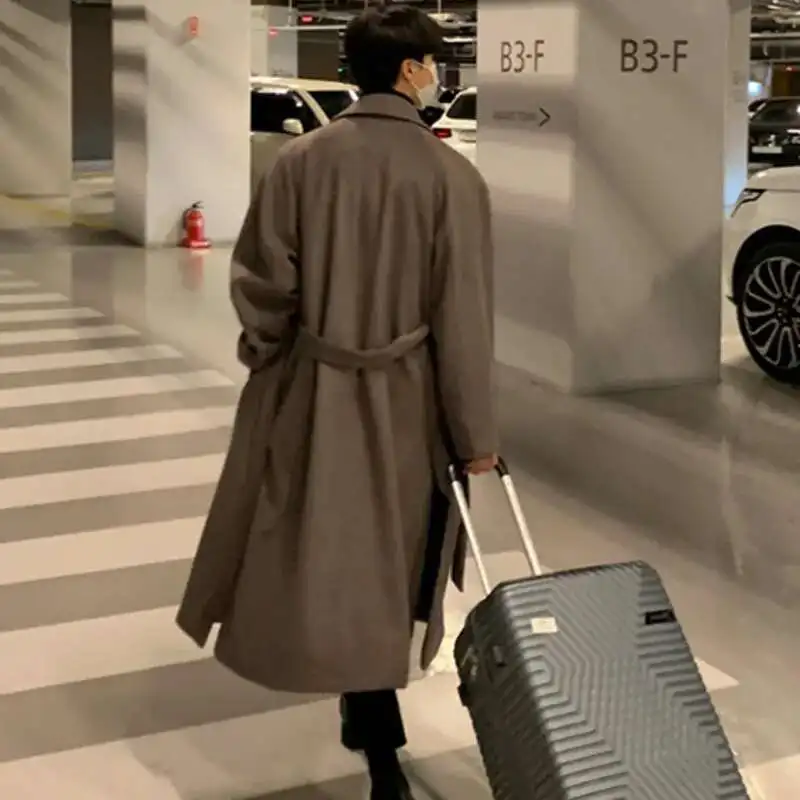
Smart-Casual Ensembles: Versatile Weekday Options
The smart-casual dress code presents the perfect opportunity for lightweight topcoats to shine. This middle-ground between formal and casual attire allows you to showcase the coat’s versatility while maintaining professional polish for various weekday settings.
Smart-casual outfit formulations that excel with lightweight topcoats include:
Oxford Shirt + Unstructured Blazer + Chinos + Suede Loafers: This quintessential smart-casual combination layers beautifully under a topcoat. Select an oxford cloth button-down in white or blue, an unstructured cotton or wool blend blazer, tailored chinos, and suede loafers in brown or navy. A camel or navy topcoat completes this refined yet comfortable ensemble.
Merino Turtleneck + Tailored Trousers + Chelsea Boots: For cooler days, this combination offers sophistication without stuffiness. Choose a fine merino wool turtleneck in a solid tone, tailored wool or cotton blend trousers with minimal break, and leather Chelsea boots. A gray or olive topcoat provides the perfect finishing touch.
Chambray Shirt + Knit Tie + Dark Denim + Brogue Boots: This combination balances casual and formal elements masterfully. Pair a textured chambray shirt with a slim knit tie, dark indigo denim with minimal details, and leather brogue boots. A navy or brown topcoat enhances the refined workwear aesthetic.
When selecting textures for smart-casual settings, incorporate at least one textural element (knit tie, textured shirt, suede shoes) to add visual interest. For pattern incorporation, follow the rule of scale variation—if your topcoat features a subtle pattern, keep shirt patterns proportionally smaller.
Business-appropriate accessories might include woven leather belts, simple pocket squares, and minimalist leather portfolios or briefcases that complement your shoes.
For additional layering strategies with smart-casual attire, exploring light mens topcoats effortless layering provides practical guidance for creating polished combinations.
Formal Styling: Topcoats for Professional Settings
Lightweight topcoats excel at complementing tailored clothing for business and formal occasions. Their refined silhouette enhances structured garments beneath while providing practical protection from the elements.
For formal settings, consider these styling approaches:
Over Tailored Suits: When pairing a topcoat with a suit, ensure proper color coordination. Navy topcoats complement virtually all suit colors, while gray topcoats work particularly well with navy and charcoal suits. Camel topcoats create striking contrast with navy or gray suits. The topcoat should be slightly longer than the suit jacket, creating clean lines when worn together.
With Dress Shirts and Ties: For business settings that don’t require full suiting, lightweight topcoats elevate shirt-and-tie combinations effectively. Balance proportions by matching tie width to lapel width—both should be in the medium range (approximately 2.75-3 inches) for most professional environments. Consider shirt collar spread when selecting tie knots—wider spreads require fuller knots.
Paired with Formal Trousers and Dress Shoes: When wearing separate trousers rather than full suits, maintain formality through proper shoe selection. Oxford dress shoes in black or dark brown pair seamlessly with wool dress trousers and lightweight topcoats for refined professional appearance.
For formal settings, topcoat fabrics should feature tight, smooth weaves that present clean lines and minimal texture. Lightweight wool and wool blends with subtle herringbone or birdseye patterns maintain professionalism while adding visual interest.
Formal accessories should remain understated yet intentional—consider tonal pocket squares, leather gloves in brown or black, and structured leather briefcases that match your footwear.
Those seeking luxurious options for business environments might explore cashmere overcoat collections for their exceptional drape and refined appearance. Understanding proper perfect winter coat length guide helps maintain professional proportions even in colder weather.
Mens Double Breasted Pea Coat, Mens Wool Blend Coat, Mens Wool Pea Coat
Price range: $136.84 through $157.36 Select options This product has multiple variants. The options may be chosen on the product pageMens Cashmere Overcoat, Mens Hooded Winter Coat, Mens Wool Blend Coat
Price range: $128.72 through $139.68 Select options This product has multiple variants. The options may be chosen on the product pageMens Black Overcoat, Mens Black Wool Coat, Mens Wool Overcoat
$339.18 Select options This product has multiple variants. The options may be chosen on the product pageMens Grey Overcoat, Mens Wool Blend Coat, Mens Wool Overcoat
$201.28 Select options This product has multiple variants. The options may be chosen on the product pageMens Herringbone Coat, Mens Long Overcoat, Mens Wool Overcoat
Price range: $197.16 through $203.69 Select options This product has multiple variants. The options may be chosen on the product pageMens Long Overcoat, Mens Topcoats
Price range: $189.40 through $196.88 Select options This product has multiple variants. The options may be chosen on the product page
The Art of Layering: Maximizing Versatility
Mastering layering techniques allows you to extend your lightweight topcoat’s wearability across seasons while creating visually appealing outfits. Thoughtful layering transforms a simple topcoat into a versatile year-round garment.
The “rule of thirds” provides an excellent foundation for visually appealing layering—divide your outfit into three approximately equal vertical sections (top, middle, bottom) with distinct colors or textures. For example, a light blue shirt (top), navy blazer (middle), and gray trousers (bottom) create balanced proportions beneath a camel topcoat.
Seasonal layering strategies include:
Spring Layers: Lightweight knits like merino wool sweaters (under 10oz/280g) and shirt jackets in cotton or linen blends provide just enough warmth without bulk. These mid-layers should fit close to the body to avoid adding unnecessary volume beneath the topcoat.
Summer Evening Layers: For cool summer evenings, lightweight linen shirts or cotton polos worn alone under a topcoat offer just enough protection while remaining breathable. Open-front wearing without buttoning the coat maximizes airflow for comfort.
Early Fall Layers: Medium-weight cardigans and lightweight vests create effective insulation as temperatures begin to drop. These pieces should end at or slightly below the waist to prevent bunching beneath the topcoat.
Texture variation creates visual interest in layered outfits—combine smooth topcoat fabrics with knits, oxford cloths, and textured trousers for dimension. When layering multiple pieces, graduate from thinnest to thickest moving outward from your body.
To layer without adding bulk, focus on thin, high-quality materials that provide warmth without volume. Merino wool, fine cashmere, and technical fabrics with thermal properties excel in this regard. Maintain consistent sleeve lengths between layers, with each outer layer slightly longer than the one beneath it.
For seasonal adaptation strategies, exploring mastering spring topcoat mens styling provides practical approaches to transitional weather dressing.
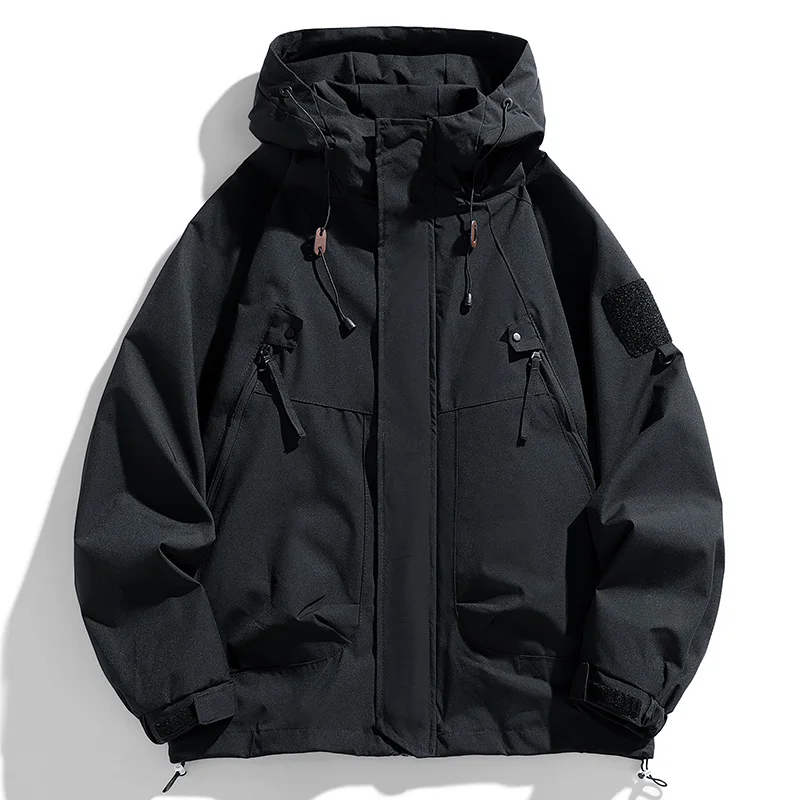
Accessorizing Your Lightweight Topcoat
Strategic accessories transform a lightweight topcoat from merely functional to exceptionally stylish. The right complementary pieces enhance your coat’s appearance while expressing personal style and adapting to specific conditions.
Key accessories that elevate lightweight topcoats include:
Scarves: For lightweight topcoats, select scarves in appropriate weights—silk and lightweight cotton for milder days, fine merino and cashmere blends for cooler conditions. The Parisian knot (folding the scarf lengthwise, draping around the neck, and pulling the ends through the fold) works particularly well with topcoats, creating a clean line without excessive bulk.
Gloves: Leather gloves in colors that complement your coat provide both warmth and sophistication. For lightweight topcoats, unlined or thinly lined gloves maintain proportional balance. Match glove color to your shoes or belt for cohesive styling—brown gloves with brown shoes, black gloves with black shoes.
Hats: Select hat styles based on both formality and face shape. Fedoras and trilbys complement oval and square faces with formal topcoats, while flat caps and wool beanies suit round and heart-shaped faces with casual topcoats. Hat colors should generally match or be slightly darker than your coat for balanced proportions.
Bags: Select bags that match your coat’s formality level—structured leather briefcases complement formal topcoats, while soft leather messenger bags and canvas totes pair well with casual interpretations. Ensure bag colors complement your shoes and belt for cohesive appearance.
Balance accessories with your coat’s style by following the “rule of three”—limit statement accessories to no more than three items to prevent overwhelming your look. Consider the short vs long coats guide when selecting accessories, as coat length significantly impacts overall proportions.
Seasonal adjustments might include lighter scarves in spring, leather card holders instead of wallets in summer, wool scarves in fall, and lined gloves in early winter—each adapting to the conditions while complementing your topcoat’s appearance.
Care and Maintenance: Preserving Your Investment
Proper care significantly extends a lightweight topcoat’s lifespan and maintains its styling versatility. Different materials require specific approaches to cleaning and storage for optimal preservation.
For specific materials, follow these care guidelines:
Cotton and Cotton Blends: Most cotton topcoats can be professionally dry-cleaned or machine washed on gentle cycles with cold water, depending on the lining and construction. Spot-clean minor stains with a damp cloth and mild detergent. Air dry cotton coats on wide wooden hangers to maintain shape.
Wool and Wool Blends: Always dry clean wool topcoats to prevent shrinkage and maintain structure. Between cleanings, use a soft clothes brush to remove surface dirt and refresh the nap. Address minor stains immediately with a damp cloth before they set.
Technical Fabrics: Many modern technical fabrics benefit from specialized cleaning to maintain water-repellent properties. Follow manufacturer instructions carefully—some permit gentle machine washing while others require professional cleaning. Avoid fabric softeners which can damage technical finishes.
Delicate Materials: Cashmere and silk blends require professional cleaning exclusively. Store these materials with cedar blocks rather than mothballs to prevent odor transfer while protecting against pests.
Proper storage techniques preserve a topcoat’s shape between wearings. Always use wide, contoured wooden hangers that support the shoulders properly. Allow 24 hours between wearings to permit natural fiber recovery. During off-seasons, store cleaned topcoats in breathable garment bags—avoid plastic covers which trap moisture and promote mildew.
High-wear areas like cuffs, pockets, and collars benefit from preventive care. Consider reinforcing buttons with additional stitching before they loosen, and promptly address minor lining tears before they expand.
Top Styling Mistakes to Avoid
Even quality topcoats can be undermined by common styling errors. Recognizing and avoiding these mistakes ensures your lightweight topcoat presents its best appearance in any setting.
Common styling errors and their solutions include:
Improper Proportions: Topcoats that are too long create a drowning effect, while those too short for your height look awkwardly truncated. Solution: For most men, lightweight topcoats should end somewhere between mid-thigh and just above the knee, with taller men favoring slightly longer lengths for balance.
Inappropriate Seasonal Weight: Wearing topcoats too heavy for mild weather creates uncomfortable overheating and excessive wrinkling from removal. Solution: Reserve topcoats over 20oz (567g) for colder weather, opting for options under 15oz (425g) for transitional seasons.
Mismatched Formality Levels: Pairing a structured formal topcoat with very casual attire creates visual disconnect. Solution: Match your topcoat’s formality to your outfit—structured wool topcoats complement business attire, while unstructured cotton or technical fabric options better suit casual settings.
Over-Accessorizing: Combining too many statement accessories overwhelms the clean lines of a lightweight topcoat. Solution: Limit bold accessories to one or two items, allowing the topcoat itself to remain the focal point.
Neglecting Collar/Lapel Positioning: Flattened or unevenly positioned collars create a disheveled appearance. Solution: Take a moment to properly position your topcoat’s collar and lapels after putting it on—stand collars should be symmetrically upright, while notch and peak lapels should lie flat against the chest.
Addressing these common errors significantly enhances your topcoat’s appearance. For seasonal appropriateness guidance, exploring best lightweight coats mild weather provides practical advice for temperature-appropriate styling.
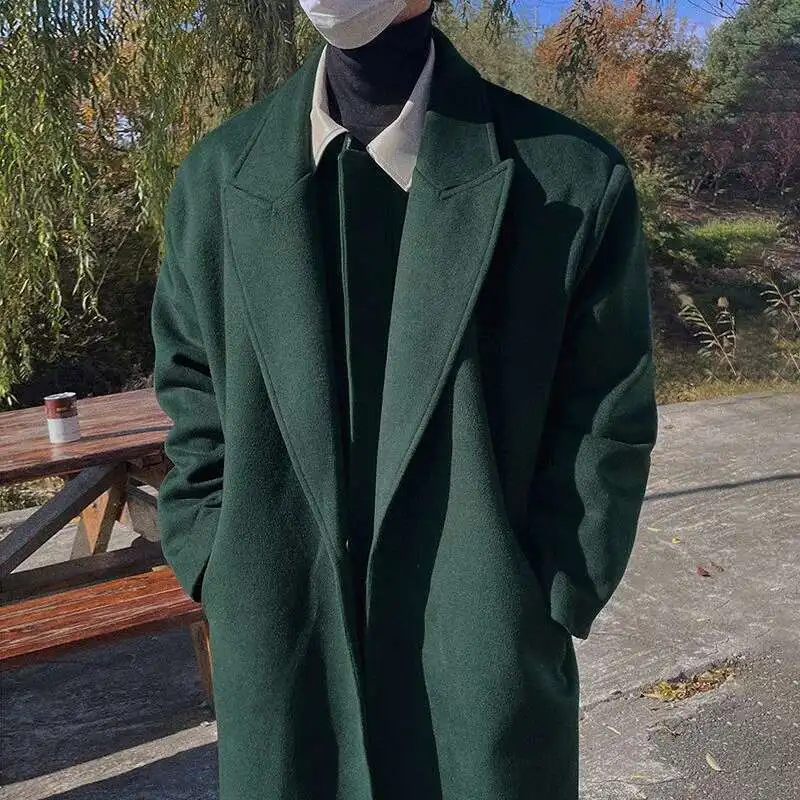
Supplemental Content: Is a Lightweight Topcoat Right for Your Climate?
Climate considerations significantly impact a lightweight topcoat’s functionality in your wardrobe. Understanding these factors helps determine whether such garments merit investment in your specific location.
Lightweight topcoats typically perform best in temperature ranges between 50-65°F (10-18°C), making them ideal for spring and fall in moderate climates. They provide sufficient protection from mild winds and light precipitation without causing overheating during activity.
For warmer climates, several adaptations maximize topcoat utility:
– Select the lightest possible fabrics like tropical wool (under 9oz/255g), cotton-linen blends, or technical fabrics with moisture-wicking properties
– Opt for unlined or partially lined construction to reduce heat retention
– Wear the coat open rather than buttoned to promote air circulation
– Choose lighter colors that reflect rather than absorb heat
In cooler climates, lightweight topcoats remain valuable through strategic adjustments:
– Layer effectively with merino or cashmere mid-layers to extend wearability into cooler temperatures
– Select slightly heavier weight fabrics within the lightweight category (12-15oz/340-425g)
– Consider double-breasted styles which provide additional chest coverage
– Incorporate accessories like scarves and lightweight gloves to enhance warmth
For transitional seasons, lightweight topcoats excel as versatile outer layers—warm enough for morning commutes yet comfortable for afternoon returns. Those seeking options for varied weather conditions might explore the mens overcoats collection for different weight options.
Supplemental Content: How Many Lightweight Topcoats Should You Own?
The optimal number of lightweight topcoats depends primarily on your lifestyle, climate, and existing wardrobe. Rather than accumulating unnecessarily, a strategic approach to building a topcoat collection maximizes versatility while minimizing redundancy.
The “one, three, five” approach provides practical guidance:
Essential First Purchase: If owning just one lightweight topcoat, select a single-breasted navy or charcoal option in a medium-weight wool blend. This versatile foundation piece complements both business and casual attire while functioning across multiple seasons.
Core Three-Coat Collection: For those ready to expand, a well-rounded three-coat wardrobe might include:
– A navy single-breasted wool topcoat for business settings
– A camel topcoat for versatile smart-casual styling
– A gray or olive option in a slightly more casual cut for weekend wear
Complete Five-Coat Wardrobe: Enthusiasts seeking comprehensive options might consider:
– A navy formal topcoat for business settings
– A camel coat for versatile wear
– A gray option for casual versatility
– A patterned topcoat (subtle herringbone or check) for visual interest
– A technical fabric option for inclement weather
When building your collection, prioritize based on your most frequent activities. Those in formal business environments should invest first in refined options, while those with casual lifestyles might prioritize more relaxed silhouettes and fabrics.
By thoughtfully selecting complementary pieces rather than duplicative ones, even a small topcoat collection can address numerous styling scenarios effectively.


